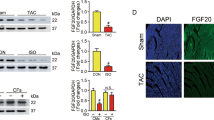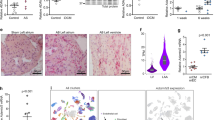Abstract
TGF-β1 plays an important role in cardiac fibrosis, apoptosis, induction of hypertrophy and contractile dysfunction. This study investigates whether TGF-β1 plays a role in laminin receptor 37/67 (37/67 LR)-dependent regulation of cardiac performance. Therefore, isolated adult cardiomyocytes were stimulated with TGF-β1, the expression of the 37/67 LR was determined and cell shortening was investigated on cells attached to a non-specific, serum-based attachment substrate or to specific, laminin-coated dishes. The role of the MAP kinases in TGF-β1-dependent induction of the 37/67 LR was examined by addition of PD98059, SB202190 and SP600125. Finally, the expression of receptor mRNA was investigated in transgenic mice constitutively over-expressing TGF-β1 and the relationship to distress score and lung wet weight-to-body weight was analysed. TGF-β1 induced a significant increase of the 37/67 LR mRNA and protein expression. The cytokine induced p38 MAP kinase and JNK, but not ERK. Inhibition of either p38 MAP kinase or JNK attenuated the TGF-β1-dependent increase in 37/67 LR expression. TGF-β1 induced a loss of cell shortening in cells attached to a non-specific substrate, but not in cells on a pre-coated laminin matrix. Inhibition of JNK attenuated the protective effect of laminin receptor up-regulation on cardiac performance. Inhibition of p38 MAP kinase attenuated the depressive effect of TGF-β1 on basal cell shortening. In transgenic mice over-expressing TGF-β1 a strong induction of laminin receptor expression attenuated the severeness of the mice’ symptoms. This study shows a new and protective role of TGF-β1-dependent up-regulation of the 37/67 LR in cardiomyocytes in cardiac remodelling with increased laminin expression.





Similar content being viewed by others
References
Boluyt MO, Bing OH, Lakatta EG (1995) The ageing spontaneously hypertensive rat as a model of the transition from stable compensated hypertrophy to heart failure. Eur Heart J 16(Suppl N):19–30
Dubus I, Rappaport L, Barrieux A, Lompre AM, Schwartz K, Samuel JL (1993) Contractile protein gene expression in serum-free cultured adult rat cardiac myocytes. Pflugers Arch 423:455–461
Frantz S, Behr T, Hu K, Fraccarollo D, Strotmann J, Goldberg E, Ertl G, Angermann CE, Bauersachs J (2007) Role of p38 mitogen-activated protein kinase in cardiac remodelling. Br J Pharmacol 150:130–135
Frantz S, Hu K, Adamek A, Wolf J, Sallam A, Maier SK, Lonning S, Ling H, Ertl G, Bauersachs J (2008) Transforming growth factor beta inhibition increases mortality and left ventricular dilatation after myocardial infarction. Basic Res Cardiol 103:485–492
Gloe T, Pohl U (2002) Laminin binding conveys mechanosensing in endothelial cells. News Physiol Sci 17:166–169
Hao GH, Niu XL, Gao DF, Wei J, Wang NP (2008) Agonists at ppar-gamma suppress angiotensin ii-induced production of plasminogen activator inhibitor-1 and extracellular matrix in rat cardiac fibroblasts. Br J Pharmacol 153:1409–1419
Klein G, Schaefer A, Hilfiker-Kleiner D, Oppermann D, Shukla P, Quint A, Podewski E, Hilfiker A, Schroder F, Leitges M, Drexler H (2005) Increased collagen deposition and diastolic dysfunction but preserved myocardial hypertrophy after pressure overload in mice lacking PKCepsilon. Circ Res 96:748–755
Larson DF, Ingham R, Alwardt CM, Yang B (2004) Tgf-Beta1 overexpression: a mechanism of diastolic filling dysfunction in the aged population. J Extra Corpor Technol 36:69–74
Li RK, Li G, Mickle DA, Weisel RD, Merante F, Luss H, Rao V, Christakis GT, Williams WG (1997) Overexpression of transforming growth factor-beta1 and insulin-like growth factor-i in patients with idiopathic hypertrophic cardiomyopathy. Circulation 96:874–881
Lijnen PJ, Petrov VV, Fagard RH (2000) Induction of cardiac fibrosis by transforming growth factor-beta(1). Mol Genet Metab 71:418–435
Mufti S, Wenzel S, Euler G, Piper HM, Schlüter KD (2008) Angiotensin ii-dependent loss of cardiac function: mechanisms and pharmacological targets attenuating this effect. J Cell Physiol 217:242–249
Ramirez MT, Sah VP, Zhao XL, Hunter JJ, Chien KR, Brown JH (1997) The MEKK-JNK pathway is stimulated by alpha1-adrenergic receptor and ras activation and is associated with in vitro and in vivo cardiac hypertrophy. J Biol Chem 272:14057–14061
Ruf S, Piper M, Schluter KD (2002) Specific role for the extracellular signal-regulated kinase pathway in angiotensin II- but not phenylephrine-induced cardiac hypertrophy in vitro. Pflugers Arch 443:483–490
Sadoshima J, Montagne O, Wang Q, Yang G, Warden J, Liu J, Takagi G, Karoor V, Hong C, Johnson GL, DE Vatner, Vatner SF (2002) The MEKK1-JNK pathway plays a protective role in pressure overload but does not mediate cardiac hypertrophy. J Clin Invest 110:271–279
Sakata Y, Chancey AL, Divakaran VG, Sekiguchi K, Sivasubramanian N, Mann DL (2008) Transforming growth factor-beta receptor antagonism attenuates myocardial fibrosis in mice with cardiac-restricted overexpression of tumor necrosis factor. Basic Res Cardiol 103:60–68
Schluter KD, Schreiber D (2005) Adult ventricular cardiomyocytes: isolation and culture. Methods Mol Biol 290:305–314
Schluter KD, Simm A, Schafer M, Taimor G, Piper HM (1999) Early response kinase and PI 3-kinase activation in adult cardiomyocytes and their role in hypertrophy. Am J Physiol 276:H1655–H1663
Schroder D, Heger J, Piper HM, Euler G (2006) Angiotensin II stimulates apoptosis via tgf-beta1 signaling in ventricular cardiomyocytes of rat. J Mol Med 84:975–983
See F, Thomas W, Way K, Tzanidis A, Kompa A, Lewis D, Itescu S, Krum H (2004) P38 mitogen-activated protein kinase inhibition improves cardiac function and attenuates left ventricular remodeling following myocardial infarction in the rat. J Am Coll Cardiol 44:1679–1689
Seeland U, Haeuseler C, Hinrichs R, Rosenkranz S, Pfitzner T, Scharffetter-Kochanek K, Bohm M (2002) Myocardial fibrosis in transforming growth factor-beta(1) (tgf-beta(1)) transgenic mice is associated with inhibition of interstitial collagenase. Eur J Clin Invest 32:295–303
Singal T, Dhalla NS, Tappia PS (2009) Regulation of c-fos and c-jun gene expression by phospholipase C activity in adult cardiomyocytes. Mol Cell Biochem 327:229–239
Tomy PM, Anilkumar NP, Sudhakaran PR (1994) Multiple laminin binding proteins in human fetal heart. Dev Growth Differ 36:333–340
Van Linthout S, Seeland U, Riad A, Eckhardt O, Hohl M, Dhayat N, Richter U, Fischer JW, Böhm M, Pauschinger M, Schultheiss HP, Tschöpe C (2008) Reduced MMP-2 activity contributes to cardiac fibrosis in experimental diabetic cardiomyopathy. Basic Res Cardiol 103:319–327
Wenzel S, Abdallah Y, Helmig S, Schäfer C, Piper HM, Schlüter KD (2006) Contribution of PI 3-kinase isoforms to angiotensin II- and alpha-adrenoceptor-mediated signalling pathways in cardiomyocytes. Cardiovasc Res 71:352–362
Wenzel S, Soltanpour G, Schlüter KD (2005) No correlation between the p38 MAPK pathway and the contractile dysfunction in diabetic cardiomyocytes: hyperglycaemia-induced signalling and contractile function. Pflugers Arch 451:328–337
Xiao H, Zhang YY (2008) Understanding the role of transforming growth factor-beta signalling in the heart: overview of studies using genetic mouse models. Clin Exp Pharmacol Physiol 35:335–341
Acknowledgments
The authors thank Nadine Lorenz, Peter Volk, and Daniela Schreiber for excellent technical assistance. Financial support of this study by the start up fund of the JLU Giessen is gratefully acknowledged.
Conflict of interest statement
None.
Author information
Authors and Affiliations
Corresponding author
Electronic supplementary material
Below is the link to the electronic supplementary material.
395_2010_108_MOESM1_ESM.doc
Characterisation of the transgenic mouse model. Given is the division into the four quartiles based on the 37/67 LR expression. The following functional data are displayed: heart rate as beats per minute (HR bpm), systolic blood preasure (BPsys mmHg), rate pressure product (RPP mmHg/min), body weight (BW g), heart weigth (HW mg), lung wet weight (LW mg) and the ratio of heart weight to body weight (HW/BW mg/g). As parameters reflecting remodelling processe the expressions of the extracellular matrix proteins elastin, collagen, laminin, and fibonectin and of TGF-β, ANF, and MMP12 are given as x-fold expression of quartile 1. *, p<0.05 vs. quartile 1; #, p<0.05 vs. quartile 3. Supplementary material 1 (DOC 20 kb)
395_2010_108_MOESM2_ESM.ppt
mRNA Expression of Laminin and the 37/67 LR of the myocyte fraction (CMC) and the non-myocyte fraction (n-CMC) seperated fron hearts of the transgenic mice. Laminin was almost not expressed in the myocyte fraction in contrast to the non-myocyte fraction, indicating that indeed laminin is a product of non-cardiomyocytes, most likely fibroblasts. But the expression of the 37/67 LR was almost equal in both fractions Data are means±s.e.m. from n=5 mice. *, p<0.05 vs. CMC. Supplementary material 2 (PPT 39 kb)
Rights and permissions
About this article
Cite this article
Wenzel, S., Henning, K., Habbig, A. et al. TGF-β1 improves cardiac performance via up-regulation of laminin receptor 37/67 in adult ventricular cardiomyocytes. Basic Res Cardiol 105, 621–629 (2010). https://doi.org/10.1007/s00395-010-0108-1
Received:
Revised:
Accepted:
Published:
Issue Date:
DOI: https://doi.org/10.1007/s00395-010-0108-1




